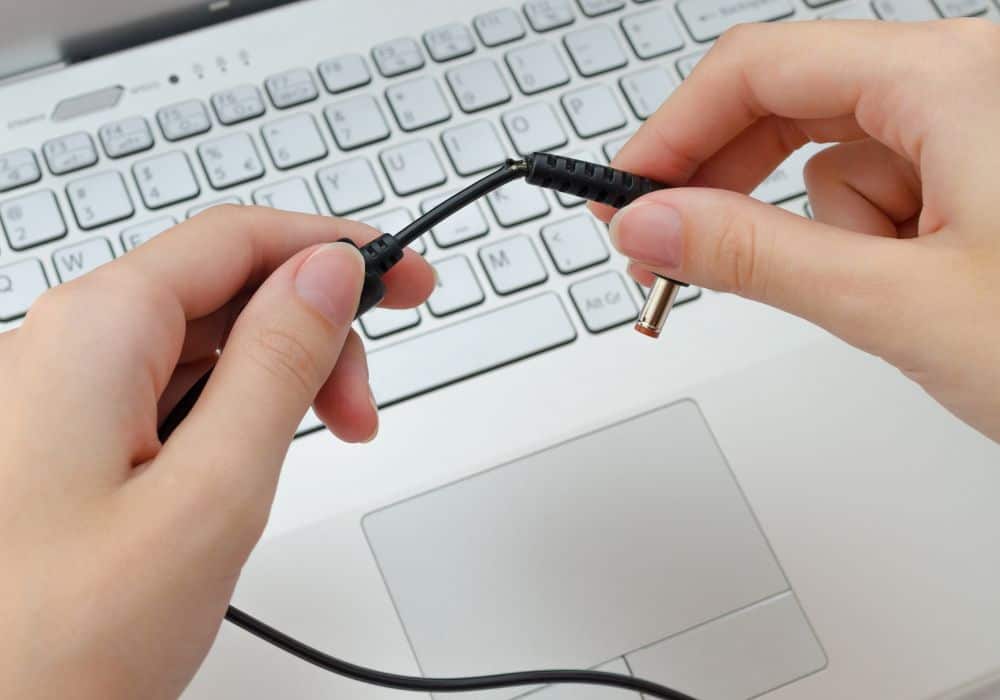You have probably experienced this several times: you are using your computer, playing games, or writing something, and suddenly you see that your battery is dying even though the battery charger is plugged into the outlet.
This is highly frustrating, mainly because there is no apparent ‘culprit’ for the charger malfunctioning, and then you have to take some steps to get to the bottom of the issue.
However, if you follow the simple instructions in this article, troubleshooting your battery charger will not be another headache. The problems with your battery charger are connected to the charger’s functionality, your laptop, or there might be an issue with the outlet.
Table of Contents
Battery Charger Not Working?
The most common causes for your battery not charging include issues with the battery’s temperature, poor input source, or safety timer expirations. Let’s see how you can fix your charger!
1. Check the Cable Connections

One of the most annoying questions that you can get from an operator or a technician w when you are experiencing problems with the charger is that they ask whether the cables are connected and whether you have plugged in the charger.
Although it will make you raise your eyebrow and sigh, the thing is that it happens more often than you would think. We spend hours trying to find the problem only to see that we have made a minor mistake, such as not plugging in the laptop or charger correctly.
So, to eliminate this dilemma, check your laptop and AC outlet to ensure that they are firmly seated and connected. Then, go to your AC adapter brick and check whether the cables are all plugged in firmly and fully.
Sometimes it seems like the cable is in the outlet, but it’s actually barely making a connection. Also, check the battery’s compartment for any wires sticking out, faulty contact points, and anything out of the ordinary.
If you check all the mentioned above, you need to determine whether your outlet is working correctly.
Plug the power cord into a different outlet to inspect whether there is a blown fuse. If the cord is plugged into a power strip, take it out and plug it into the wall. If it is still not working even though you have determined that the outlets are fine, the issue is with the laptop or charger.
2. Test Your Battery

How can I test my battery? It is very simple! First, check the battery’s integrity by removing its plug from the laptop and holding the power button for 15 seconds. Then, turn your computer on with the battery still removed.
If the laptop continues to power usually, the issue is with the power adapter- you most likely have a bum buttery. To fix this, you can try to reinstall the battery because sometimes batteries are poorly seated or sealed, and that can cause them to fail to charge.
If your laptop has a built-in battery compartment, which is not visible, that means that you will have to open it or call a specialist to check and test your battery. Again, if this is your first time doing this and you have no experience, we suggest you call a repair specialist.
3. Which USB-C Port Are You Using?
Although there is a low chance that the USB-C charging port on your laptop is data-only, meaning it cannot charge your device, it is worth checking it out. Today, USB-C is used to connect peripherals, transfer data and charge the battery, but some ports cannot charge the battery.
Some laptops or other devices come with two USB-C ports; one is for charging and data transfer; the second is only for transferring data. If you see that the battery charger is not working, although connected, check what type of USB-c port you have.
Some devices have an icon that shows you which port is meant for charging and data transfer.
4. Inspect the Power Cord
This is a common reason your battery will not charge your laptop. Sometimes the power cord sustains damage, tears, and cuts, and the wires get exposed. Bare, exposed, and unprotected wires are a serious fire hazard; therefore, you ought to check them!
Start by feeling along the length of the power cord, and bend or flex it to see if there are any kinks or tears. In addition, inspect the ends; maybe there are broken connections or your plugs are loose. Damage to the plugs can happen without you noticing it, and if you have pets, perhaps they have chewed them.
While at it, check the AC brick; if it is discolored, warped, or expanded, that is the root of your problem. Also, please give it a sniff test to check whether it is burnt. If it is, you will have to buy a new power connector.
5. Is Your Battery Overheating?

Several issues can cause your charger to stop working, and one of the common ones is overheating the battery or laptop. Unfortunately, this is also a recurring problem with batteries in general, as they are highly susceptible to heat.
One of the primary reasons your battery is overheating is that the fan might be covered in dust or dirt, preventing it from functioning correctly. In addition, overheated batteries lose their charge quickly and can also pose a threat to you and your family because they sometimes explode.
When you are charging the battery, the temperature rises, and the battery sensors fail to discharge correctly; it tells the system that the battery is fully charged or empty. Either way, it is not powering the laptop.
If your laptop shuts down unexpectedly, this can also mean that there is a problem with the battery because that happens to prevent further overheating and potential fire. However, this issue is mainly connected to the older version of laptops.
Modern devices usually have a higher-quality cooling system, so this is unlikely to happen. On the other hand, you can block the cooling fans if you use them while sitting on the couch. To check if this is the problem, turn off the laptop and let it cool off for a while.
Then inspect its air vents and fans to see if something is blocking them. Remember, constantly overheating your battery and laptop can affect both and cause them to die.
6. Maybe You Need to Update the Battery Drivers
Depending on the type of laptop and the battery, there is also a possibility that you need to install new drivers for the battery. How to do it? Follow these steps:
Step 1: Open the start menu and click the Device Manager. Under batteries, there is a list of items attached to the laptop, including the charger and battery.
Step 2: Right-click on the items and pick Update driver.
Step 3: After the successful update, reboot the laptop, turn it on, and plug in the battery.
If this does not solve the issues, your battery may need specific drivers like those from the manufacturer’s site. On the other hand, you can also uninstall the battery driver and reboot it. This will prompt the operating system to reinstall the drivers, but this time the right ones.
If your laptop comes with a removable battery, this will be an easy task; basically, you shut down the power, remove the battery, disconnect the power, and then press the power button for 5-10 seconds. Next, insert the battery and turn on the laptop.
If you are using a Mac, you will have to reset the System Management Controller.
7. Are You Using the Right Charger?
Sometimes consumers buy chargers that fit their laptop’s charging point, but this does not imply that you are using a suitable charger. The charger may not be powerful enough for your computer because of its low wattage.
Always refer to the official or manufacturer’s charger because it has the correct wattage and is powerful enough for your laptop, so we suggest you stick with that adapter. Even though the lower-wattage charger will not drain the battery, it will not be able to charge it any higher.
This usually results in a prolonged charging process. Furthermore, if you are using several power-hungry programs at once, they will take up more battery power at a higher rate.
Open the task manager and check resource usage to determine whether you are overloading your charger.
8. Maybe You Need a New Charger
After you have checked everything on the list, and the charger is still not working, you need to consider that the charger or laptop is faulty because regardless of what you check and do, it still will not work.
While purchasing the new charger, we recommend you skip the inexpensive Amazon and eBay chargers and buy an official charger. Although they tend to be more expensive, with these chargers you get what paid for!
They are far more reliant and stable, so if you can afford and find it, go for the genuine charger. When buying a charger, keep an eye on the voltage and whether it corresponds with your laptop’s voltage requirements.
On the other hand, this issue can also result from a poor charging system because the chargers perform in high temperatures or corrosive environments, affecting their overall performance.
Conclusion
Hopefully, you have found what is wrong with your laptop battery charger and can resume your daily activities. However, if you have inspected the power cord, drivers, wires, cable connection, and connectors, the problem lies within the charger or your laptop.
In that case, contact a repair shop or a technician to get to the bottom of the problem.
Have you tried fixing your battery charger? Please share your experience! If you have any questions, do not hesitate to ask!
